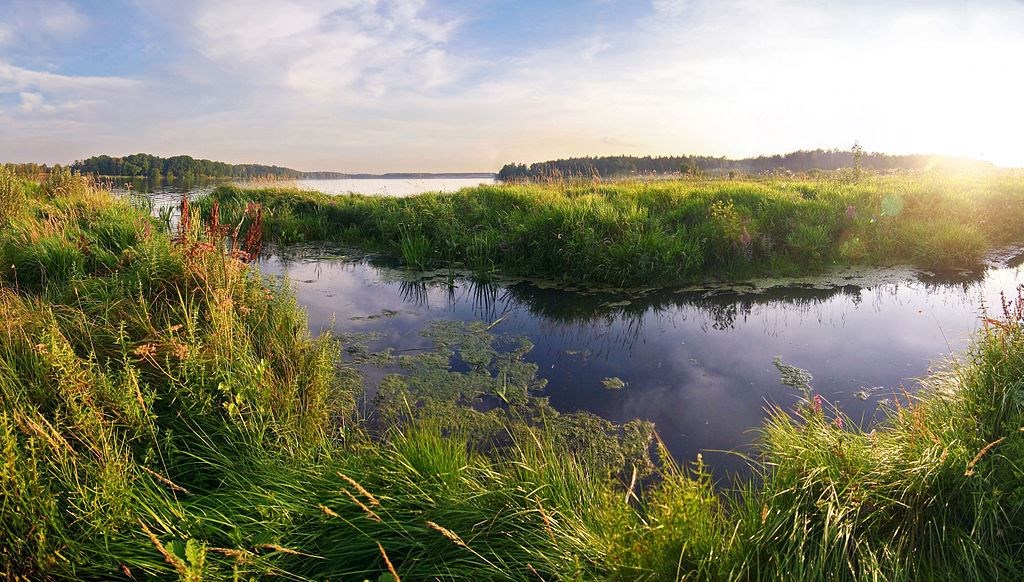 Wetlands near the Moscow region, Russia.By Svetlana Makarova (https://www.flickr.com/photos/womeos/3414627905/) [CC BY-SA 2.0], via Wikimedia CommonsThese are some of the
Wetlands near the Moscow region, Russia.By Svetlana Makarova (https://www.flickr.com/photos/womeos/3414627905/) [CC BY-SA 2.0], via Wikimedia CommonsThese are some of the
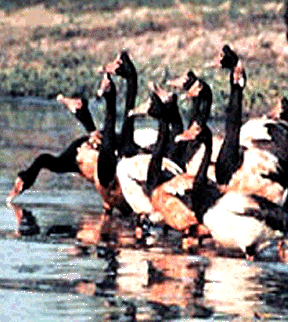 |
https://www.deh.gov.au/ssd/wetlands/northern/ |
Northern Australia is home to various climatic zones, which produce a variety of wetlands that differ greatly in their water composition. Hence, they house a great diversity of flora and fauna with different environmental needs, and, in return, different benefits to humanity.
From the arid regions of western Queensland, which often remain dry for years at a time, to the wet tropics of the northeast coast, which especially thrive in the summer monsoon period, to the expansive floodplain wetlands, the marshes and Melaleuca swamps of the coastal zone - Northern Australia is a wetland wonderland.
The wetlands of northern Australia are vital both to the numerous animals which call these ecosystems home, and to the indigenous Aboriginal peoples of the area. These wondrous natural habitats house many aquatic species such as fish, birds, and reptiles, which are vital in the nutrition and culture of Australia's Aboriginal peoples. Wetlands also offer commercial fisheries and recreational activities which promote tourism to the area.
Unlike southern Australia where wetlands have often been affected by human agriculture and industry, the wetlands of Northern Australia, particularly the floodplain wetlands, have remained largely unaffected, and continue to thrive. But, as with most of the world's wetlands, they face a number of risks to their future survival, including natural threats such as the invasion by exotic plant species, and rising sea levels which lead to saline intrusion associated with climate change, as well risks posed to them by human actions, such as inappropriate cattle grazing practices, impacts from mining, irrigation, agriculture, and vegetation clearance for development.
Hence, it is crucial, both for the well-being of the Aboriginal peoples that abide in the area, as well as to the plants and animals of the region, that these generous ecosystems be protected.
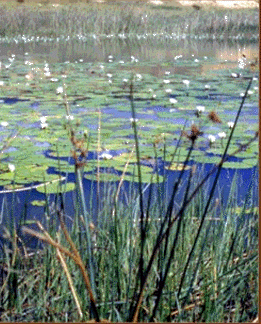 |
https://www.wetland.org.za/basics.htm |
An estuary is a water passage where the tide meets a river current, typically where a river meets the sea. The interaction of the two water sources make them especially unique. South Africa, at the southernmost tip of Africa, and home to a vast and admired coastline, is home to many of these natural habitats.
Estuaries are important because they are such specialized environments, so different from the conditions of the sea, and typically calm, sheltered, and shallow. The unique environment of estuaries makes them wonderful homes and breeding grounds for countless marine species. In South Africa, more than 100 species of fish, crabs, and prawns in off-shore waters use estuaries as nurseries and feeding grounds. Estuaries are particularly good nurseries in that they offer protection from marine predators that typically dwell in greater water depths. Also, thanks to their high temperatures and the rich food supplies of estuarine plants and the plants of the surrounding wetlands, like mangroves and reeds, they are able to grow strong. The young fish return to sea after about one year, their survival in their most formative year critically tied to the safe environment of the estuary.
But sadly, South Africa's estuaries are dwindling, thanks to a variety of factors, including non-eco-friendly tourism, motorized water vehicles which disrupt the environment, and littering. Estuaries are also threatened by the quality of the rivers which flow into them, such as those which carry contaminants such as herbicides and pesticides from farming fields they pass by, those which carry eroded soil from poorly farmed lands, creating an excess of silt, as well as those rivers which have been dammed or greatly used for irrigation or industry, creating a change in current, water depth, and the like.
Yet because estuaries are desirable locations for human habitation and use, the balance between consumption and preservation is key. Many towns depend on estuaries for harbor facilities, tourism, and recreational activities like boating and fishing. Yet likewise, countless creatures depend on estuaries for their survival, and it is imperative that these areas be conserved for their well-being, while balancing the needs of humans.
Especially important is the need for drinkable water, which wetlands like estuaries, are particularly adept in providing. But as these wetlands diminish in alarming rates, likewise does the availability of the nation's usable water. Hence, wetlands and water conservation in South Africa are of utmost importance to the future of the nation, and the livelihood of its inhabitants.
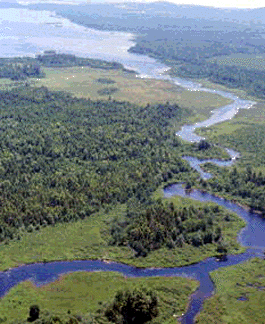 |
Credit Tom Abello, The Nature Conservancy https://www.fws.gov/feature/machiasriverphoto.htm |
The 3 million acres of wetlands in coastal Louisiana are some of the most fragile and valuable the United States has to offer. These swamps and marshes are inhabited by a great variety of species of animal and plant life. They are also important economically to humans, in that they offer recreational, agricultural, and educational activities, as well as an enormous seafood industry.
Sadly, these valuable wetlands are being lost in striking numbers. Even though the large expanse in Louisiana comprises almost 40 percent of the continental U.S.'s wetlands, it also accounts for 80 percent of the nation's wetland losses. Scientists feel that if these losses continue at their present rate, Louisiana will lose this habitat within 200 years.
While natural evolution, like shifts in the Mississippi River which cause erosion, has contributed to much of the wetland's demise, human activities like canal dredging, filling for agriculture and grazing, land development, and the creation of expansive levees that deprive the wetlands of needed river sediment are also at fault.
The impact of coastal erosion in Louisiana is enormous. Its barrier islands act as a "buffer to reduce the effects of ocean waves and currents on associated estuaries and wetlands," but these islands are eroding at alarming rates. The U.S. Geological Service estimates that several of these islands will disappear before the next century. Upon the loss of these islands, Louisiana's sheltered wetlands will be exposed to the full force of the ocean - increased wave action, storm surges, and tidal currents, posing a threat both to animal and human life, as well as to further demise from sediment and salt.
Scientists and engineers are working steadfastly to understand the process of wetlands evolution, and to find a balance between human need and needed conservation.
The Jason Expedition's 2005 team of student and teacher Argonauts and host researchers are venturing into the Louisiana wetlands, exposing classrooms around the world to the wonders of this complex ecosystem and to the need for preserving it. Together, they are learning about the wonders of the wetlands, and sharing invaluable lessons of science in action.
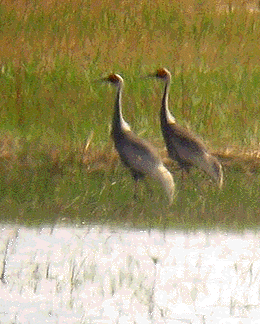 |
https://montereybay.com/creagrus/Chinacranes.html |
Comprised of the Middle East and Central Asia, the area considered Western Asia contains much of the world's main arid zones. Many types of fragile ecosystems including deserts, semi-arid lands, and mountains can be found there, but despite the prominent droughts of this often arid region, wetlands are also present. In fact, all but 3 of the 31 natural wetland types recognized by the Ramsar Convention (the main international resource on wetland protection and conservation) can be found in Western Asia, including mangroves, and coral reefs.
It is vital that wetlands found in the arid zones of the world are conserved, as their presence is essential both to the natural environment of the region, and to provide a liveable ecosystem for both humans and other creatures. The main conservation issue for most wetlands in arid zones is water supply. Some wetlands contribute to the drinking water supply of the area - of key importance to all nations, but particularly in those of arid regions - by "collecting and releasing water to groundwater systems and surface water reservoirs." These groundwater-fed wetlands help minimize the effects of droughts and water shortages during the dry season. Not having wetlands in this area would, then, affect the water supply, and potentially cause water shortages in and of themselves, in regions so dependant on natural water production.
Of key importance, then, is the management of these areas to balance human consumption with environmental protection. The products of the wetlands support its local peoples directly economically, as well as the nation that hosts them. So while supporting economic development, wetlands simultaneously protect the country's environmental well-being and the health of its peoples.
Page created on 1/12/2005 12:59:35 PM
Last edited 3/20/2018 7:33:11 PM
Swamped: Louisiana Students Become Wetlands Custodians is a short film about a service-learning project in which middle school students become stewards of the area's fragile wetland environment. The documentary is featured on edutopia.org.
